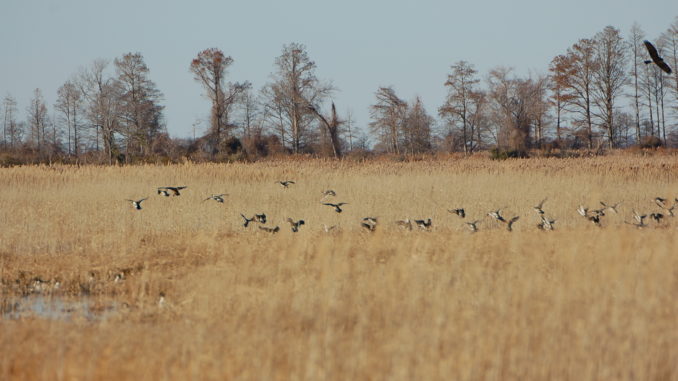
Any successful duck hunter understands the importance of being in the right place when birds are in the air. If the flock never passes by, few birds will come home to the dinner table.
Yet passing flocks rarely pass within shooting range on their way to their destination. Hunters must capture ducks’ attention by using decoys and calls. With only minimal hunting pressure on December flocks, calling and decoying will dupe these neophytes with little effort, as long as a few basic tactics are followed.
Decoys should be used to capture the attention of flying ducks. Chief Louie Chavis of the Beaver Creek Indian People relies on antique cork decoys to bring his birds into range.
“You want to get their attention,” said Chavis, who separates his diving duck decoys from his puddle duck decoys, but he will mix mallards with pintails and teal. Then, he places ring necks and canvasbacks together in another area of his spread. “The different duck species adds color to the spread, hopefully grasping the attention of passing ducks.”
Chavis wants approaching ducks to notice his spread and hopes they will take a closer look. He will use up to 100 decoys in December on large bodies of water but will scale down his spread as the season progresses.
“Ducks will be more likely to travel in large groups early than later, and I try to mimic the flock size,” he said.
Decoys alone will often cause a flock to drop to a lower altitude, but a combination of calling and decoying is often the ideal blend to get flyers to commit to a spot in the water. Chavis relies on traditional mallard-type calls, using common vocalizations used by many duck hunters, with the exception of the loud highball.
“I use the traditional chuckle-cluck, and the lonesome hen most of the time, and I only vary the volume,” he said, increasing the volume only to large flocks or on windy days when louder calling is necessary. Calling, he said, should only be used to capture the birds’ attention and keep them interested after they have made a few circles around the decoys.
“Only call to them when the birds have made a pass and are on the sides. Never call to an approaching or departing flock,” he said.
Fortunately, early birds are gullible, leaving some room for the overzealous caller. But a well-educated flock will become wary quickly when loud and aggressive calling tactics are used.




Be the first to comment